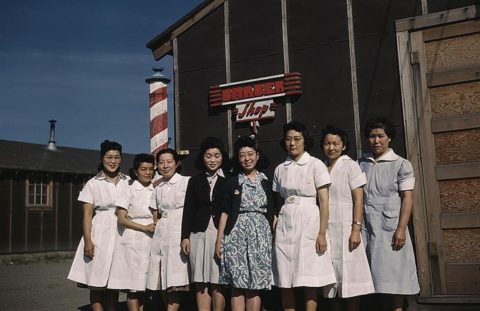Depicting Asian And Asian American Experiences: The Importance Of Authentic Storytelling

Table of Contents
The Perils of Stereotypical Asian and Asian American Representation
Harmful Stereotypes and Their Impact
Harmful stereotypes about Asian and Asian American individuals are pervasive and damaging. These stereotypes often reduce complex individuals to one-dimensional caricatures, limiting understanding and perpetuating harmful biases.
- The Model Minority Myth: This stereotype paints all Asians as high-achieving, docile, and implicitly superior to other minority groups. This ignores the struggles faced by many Asian Americans and creates unrealistic expectations while simultaneously pitting them against other marginalized communities.
- The Perpetual Foreigner: This stereotype assumes that Asian Americans, regardless of their citizenship status or how long they have lived in the country, are never truly “American.” This leads to feelings of alienation and constant questioning of their belonging.
- Submissive Female Characters: Asian women are often portrayed as docile, subservient, or hyper-sexualized, ignoring the incredible diversity of their personalities and experiences.
- Hyper-sexualized Figures: The fetishization of Asian women in media reduces them to objects of desire, ignoring their agency and individuality.
These stereotypes perpetuate prejudice and discrimination in numerous ways:
- Limited Opportunities: Stereotypes can limit opportunities in education, employment, and social interactions.
- Microaggressions: Individuals face constant subtle but hurtful comments and actions based on these stereotypes.
- Systemic Discrimination: These ingrained biases can lead to systemic discrimination in various aspects of life.
The psychological impact on individuals who see themselves misrepresented is significant:
- Internalized Racism: Individuals may internalize negative stereotypes, leading to low self-esteem and a sense of inadequacy.
- Mental Health Issues: The constant exposure to harmful stereotypes can contribute to anxiety, depression, and other mental health challenges.
The Importance of Nuance and Complexity
Moving beyond simplistic portrayals is crucial. Asian and Asian American communities are incredibly diverse, encompassing a vast array of ethnicities, nationalities, socioeconomic backgrounds, religious beliefs, sexual orientations, and experiences.
- Diversity of Identities: We need to showcase the diversity within the Asian American community—from Hmong Americans to Filipino Americans, from Korean Americans to Vietnamese Americans, and countless others. Each group has its unique history, culture, and traditions.
- Challenging Misconceptions: By showcasing this diversity, we can challenge harmful stereotypes and foster a more nuanced understanding of Asian and Asian American identities. This includes representing a wide range of socioeconomic backgrounds, not just focusing on affluent individuals. We must also acknowledge and address the complexities of immigration experiences, generational trauma, and the intersections of race, gender, and class.
Creating Authentic Asian and Asian American Narratives
The Role of Asian and Asian American Storytellers
Authentic storytelling requires the active involvement of Asian and Asian American creators. Their lived experiences are invaluable in crafting accurate and relatable stories.
- Lived Experiences: Creators from within the community possess an intimate understanding of cultural nuances, historical contexts, and the complexities of identity.
- Amplifying Underrepresented Voices: Their stories can provide crucial insights into issues that often go unheard. They can use their platforms to amplify the voices of those who have historically been marginalized.
Collaborating for Cultural Accuracy
Creating authentic narratives requires meticulous research, consultation with community members, and sensitivity to cultural nuances.
- Cultural Consultants: Collaborating with cultural consultants ensures that portrayals are accurate and respectful. This involves working closely with individuals who have deep knowledge and understanding of the specific culture being depicted.
- Community Engagement: Consulting with community members can provide valuable feedback and perspectives, ensuring that the narratives resonate authentically with the target audience.
- Successful Collaborations: Many successful films and TV shows have demonstrated the power of this collaborative approach.
Beyond Representation: Exploring Complex Themes
Authentic storytelling goes beyond simple representation; it involves exploring complex themes relevant to the Asian and Asian American experience.
- Complex Themes: These themes include immigration, generational trauma, cultural identity, racism, xenophobia, and the challenges faced by immigrants and refugees. Exploring these themes fosters a deeper understanding of the struggles and triumphs of Asian and Asian American communities.
- Fostering Empathy and Understanding: By engaging with these complex themes, we can foster greater empathy and understanding among audiences.
The Power of Authentic Storytelling in Shaping Public Perception
Challenging Misconceptions and Promoting Understanding
Authentic storytelling can dismantle harmful stereotypes and promote a more accurate and nuanced understanding of Asian and Asian American cultures.
- Challenging Stereotypes: Films, television shows, and other forms of media can present counter-narratives that challenge prevalent stereotypes and showcase the diversity of experiences within the community.
- Positive Impact on Public Perception: Accurate representation can help to correct misconceptions and foster a more positive public perception of Asian and Asian American individuals and communities.
Inspiring Action and Social Change
Authentic storytelling can inspire viewers to take action against discrimination and work towards a more equitable and inclusive society.
- Inspiring Social Change: Stories can serve as powerful catalysts for social change by raising awareness about important issues and inspiring action.
- Advocacy and Social Justice: By amplifying the voices of marginalized communities and giving a platform to their experiences, storytelling can be a powerful tool for advocacy and social justice.
Conclusion
The importance of authentic storytelling in depicting Asian and Asian American experiences cannot be overstated. Stereotypical representation perpetuates harmful biases and limits understanding. However, by centering the voices of Asian and Asian American creators and prioritizing cultural accuracy, we can create narratives that challenge misconceptions, promote empathy, and inspire positive social change. We need more stories that celebrate the diversity within our communities and explore the complex realities of our lives. Support authentic storytelling initiatives, seek out diverse media representing Asian and Asian American experiences, and demand more inclusive narratives. Let's work together to ensure that Asian representation in media is finally authentic and reflects the vibrant tapestry of our cultures and experiences. Let's champion authentic storytelling and build a more equitable and inclusive future.

Featured Posts
-
 The Unexpected Hit A Fake Henry Cavill Cyclops Trailer Goes Viral
May 12, 2025
The Unexpected Hit A Fake Henry Cavill Cyclops Trailer Goes Viral
May 12, 2025 -
 The Ethics Of Betting On Natural Disasters The Los Angeles Wildfires Example
May 12, 2025
The Ethics Of Betting On Natural Disasters The Los Angeles Wildfires Example
May 12, 2025 -
 Understanding Debbie Elliotts Contributions
May 12, 2025
Understanding Debbie Elliotts Contributions
May 12, 2025 -
 Budget Familial Conseils Et Astuces Pour Economiser Et Mieux Gerer Ses Finances
May 12, 2025
Budget Familial Conseils Et Astuces Pour Economiser Et Mieux Gerer Ses Finances
May 12, 2025 -
 Dispute Over Royal Honors For Asylum Volunteers Pvv Ministers Refusal
May 12, 2025
Dispute Over Royal Honors For Asylum Volunteers Pvv Ministers Refusal
May 12, 2025
